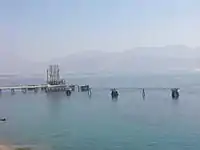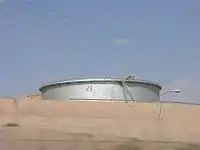Eilat Ashkelon Pipeline Company
The Eilat Ashkelon Pipeline Company (also known as Europe Asia Pipeline Company, EAPC) operates several petroleum and petroleum products pipelines in Israel, most notably the Eilat Ashkelon Pipeline. It also operates two oil terminal and depots in the country. The company was originally formed in 1968 as a 50/50% joint venture between Israel and Iran (during the Shah's rule) to transport crude oil from Iran to Europe.[1][2] After the Iranian Revolution 1979, Israel nationalized the company. In 2015, a Swiss court ordered Israel to pay Iran $1.1 billion compensation, which they refused to do, arguing that this was prohibited by its Trading with the Enemy Act.[3]
| Type | Public |
|---|---|
| Founded | 1968 |
| Headquarters | Ashkelon, 78101 , Israel |
Area served | Israel |
| Website | www.eapc.co.il |
The services of EAPC are: transporting crude oil and refined products, long term storage, crude oil blending, processing of liquefied petroleum gas, fuel oil, distillates and gas.
History



- 1956: "Afike Neft" (Crude Oil Channel) founded to transport crude oil from Sinai to Haifa
- 1957: construction of 3 oil tanks in Eilat, 20 cm (8") Ø pipeline from Eilat to Beer-Sheva, 3 oil tanks in Beer-Sheva, trains transport crude oil to Haifa, later construction of a 40 cm (16") Ø pipeline from Beer-Sheva to Ashdod and transportation by ship to Haifa
- 1959: construction of a 40 cm (16") Ø pipeline from Eilat to Haifa
- 1966: construction of the storage facility Ramat Yotam, Eilat; Jetty 1; booster station in Paran
- 1968: EAPC established, construction of a 106 cm (42") Ø pipeline from Eilat to Ashkelon, terminal and port in Ashkelon
- 1973: storage in Eilat expanded to 1.1 Mio. m3, in Ashkelon to 1.3 Mio. m3, additional booster station in Yotvata, 45 cm (18") Ø pipeline from Ashkelon to Ashdod
- 1996: construction of a sea and land terminal for fuel oil in Ashkelon
- 1998: construction of a modern LPG terminal
- 1999: joint venture EAPC and Petroleum & Energy Infrastructures Ltd. (PEI), distillates unloaded in Ashkelon und distributed/pumped by PEI
- 2000: marine services moved to Israel Electric Company (IEC), coal jetty for Rutenberg Power Station, Ashkelon
- 2002: conversion of storage tanks for distillates, filling station for tanker lorries
- 2003: reverse flow project finished (Russian oil delivered by tankers to Ashkelon, reloaded onto tankers in Eilat for shipment to Asia)
- 2004: modern filling plant for LPG cylinders
Pipelines
Crude oil pipelines
- Eilat port - Ashkelon port, 254 km, Ø 106 cm (42"), max 60 Mio. tons per year, 3 booster stations (Yotvata, Paran, Mashabei Sadeh)
- Ashkelon port - Haifa Refinery at Haifa port, 197 km, Ø 40 cm (16/18"), 3 pumping stations (Givati, Glilot, Hadera), max 5.5 Mio. tons per year
- Ashkelon port - Ashdod Refinery, 36 km, Ø 40 cm (18/16"), max 7 Mio. tons per year
Products pipeline
- Eilat port - Giv'ati - Haifa refinery, 260 km, Ø 40 cm (16"), distillates (gasoline, jet fuel, gasoil)
The bidirectional reverse flow project
This project reversed the flow direction of Eilat-Ashkelon pipeline oil - meaning that it can now flow southwards instead of only northwards, as originally conceived when Israel consumed Iranian oil. The idea behind the project is to transport crude oil from Russia, Central Asian republics and Caucasus over the Black Sea and the Baku-Tbilisi-Ceyhan pipeline to Southern Asia and the Far East at a competitive price. The capacity and size of the Suez Canal is limited and therefore expensive.
- Ashkelon port - Eilat port, 254 km, Ø 106 cm (42"), max 20 Mio. tons per year, 2 booster stations
Oil ports
- Eilat, storage capacity 1.2 Mio. m3, for tankers up to 500,000 tonnes deadweight (DWT), 16 storage tanks
- Ashkelon, storage capacity 1.5 Mio. m3, for tankers up to 300,000 DWT, 22 storage tanks
See also
- Iran–Israel relations
- Nahal Zin fuel leak from an EAPC pipeline, 2011 ecological disaster
References
- Ammann, Daniel (2009). The King of Oil: The Secret Lives of Marc Rich. New York: St. Martin‘s Press. ISBN 0-312-57074-0.
- Bialer, Uri. Fuel Bridge across the Middle East—Israel, Iran, and the Eilat-Ashkelon Oil Pipeline. In: Israel Studies, Vol 12, No 3 (Fall 2007)
- "Report: Swiss Court Orders Israel to Pay Iran $1.1 Billion in Oil Pipeline Dispute". Retrieved 27 September 2015.